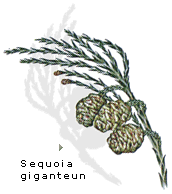 |
|
||||||||
|
|||||||||
|
 |
|
||||||||
|
|||||||||
|
 Giant Sequoia It is expectable that as times goes by and people become more imaginative and more reflexive, the vulgar name of this splendid tree becomes again "Giant Sequoia" and the one that was imposed, "Wellingtonia" (never used in USA) is little by little without being use. The Duke of Wellington has nothing to do here. A better alternative would be "mammoth tree" which is an appropriate term for the giant sequoia called "General Sherman" that is the oldest being alive in the Earth. It is difficult to think how huge this tree is, but it can help to know that in the scale of sizes of beings the second place is for the blue whale and that the biggest captured, weighted 174 tons alive, facing 2145 tons estimated for the "General Sherman". Another data of this giant tree are: 83m height; trunk perimeter from 1.5 m of the ground 24.1 m; estimated wood volume 140 m3; estimated age over 3500 years. (The "General Grant" is even a tallest tree and almost as big as the sequoia). Other giant sequoias have lived 4000 years and till recently it was believed that apart from being the biggest they were the oldest beings in the Earth, but in 1963 it was discovered that certain Colorado pines that grow in the White Mountains of California have at least 4900 years. The giant sequoias do not reach the height of the red sequoias, but there are many that have between 60 and 90 m, and the perimeter of its trunk is much bigger: many specimen have from 20 to 25m, 2 to 3m over the soil. Its foliage is completely different from the red sequoia and consists of scale and pointed needles, of 4 - 7 mm long, green-grayish in the base and dark green in the inferior part, placed helicoidally. The twigs of the branch extremes are erect, the rest are hanging and curved upwards, while the inferior branches, very heavy, are hanging but with the extremes also upwards. It produces a great number of male flowers, like yellow beads, while the female ovoid lowers, of about 1cm long, are formed on top of some yellow-rosy peduncles of 2cm height. The green ovoid cones, with flattened apex, are formed by rhomboid scales, flat with the depression in the center of each one, and can be 8 X 5 cm, although they are generally smaller. The flat winged seeds, though bigger than the red sequoia, are amazingly small to be the ones of the biggest plant of the world: in a kilogram there are 200.000. The bark is not an intense red as the red sequoia, but the softness is similar and even thicker (in the old trees can be up to 50 cm), and equally resistant to fire and other dangers. The trunk lacks spurs and is bigger and broader. As the red sequoia, the giant sequoia heartwood is red-rosy and the sapwood, yellowish; in spite of being weaker and easily broken its wood was formerly used for the same things than the red sequoia, especially for vineyard cuttings. It is almost an indestructible wood: the trees cut down several centuries ago have at least the medulla intact, while the ones that fell just 100 or 200 years ago are intact. It is often planted in parks and mansions as an ornamental tree and has great possibilities in the field of silviculture. There is a very rare cultivation called "Pendulum" with the trunk erect but hanging twigs. |
|
| 3/4/2014 5:35:44 PM |
|
| Rama Forestry Project - Estancia Rama - Provincial Route 9 Km. 72 - Valle of Pancanta -
(5701) San Luis - Argentina / TE: +54 2652 447480 / +54 2652 452000 ext 4308
rama@rama.com.ar
| |